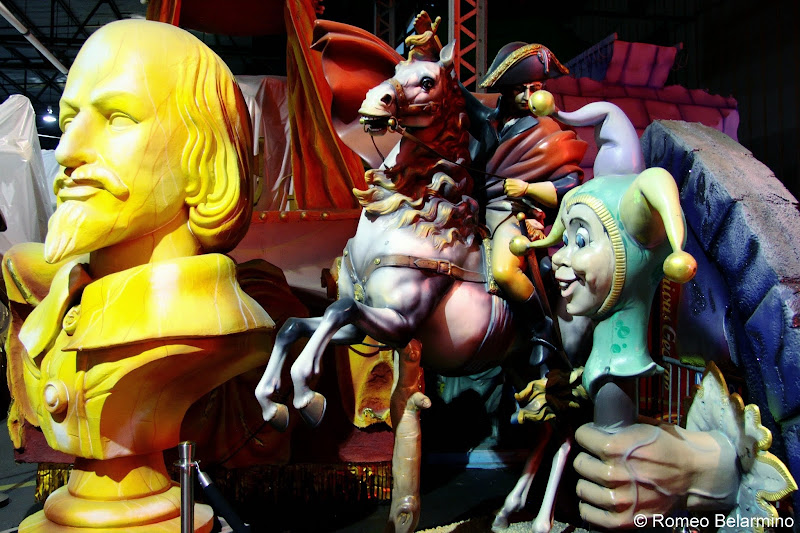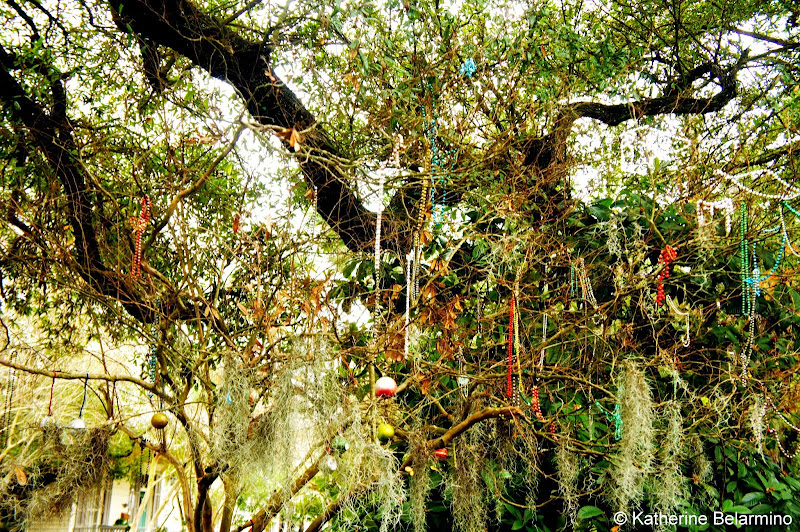Before we traveled to New Orleans
I didn’t know much about Mardi Gras. I
knew there were crowds, beads, and flashing.
I had seen clips on television of costumes and masks and floats. I had heard from one or two people that
visitors could still get a feel for Mardi Gras without going on the actual day,
but rather going in the days before, and that it was a lot less crowded then,
but I didn’t really understand what that meant.
Now that I’ve been to New Orleans, I have a much better understanding of
what Mardi Gras means, and it is so much more than one day of drunken
revelry. Even when it’s not Mardi Gras,
Mardi Gras is part of New Orleans year-round in the museums, restaurants, and
stories of the people who live there and know that Mardi Gras is the greatest
time of year.
Common Mardi Gras Misconceptions
Misconception: Mardi Gras is Just One Day
One of the most common
misconceptions about Mardi Gras is that it is just one day. There is some truth in that. Mardi Gras is French for Fat Tuesday, and Fat
Tuesday is one particular day as well as the biggest day of the Mardi Gras celebration.
But in New Orleans Mardi Gras is a
season, not just a day. Mardi Gras
season, or Carnival, starts on January 6, also called Twelfth Night or the
Feast of the Epiphany. Mardi Gras can be
any Tuesday between February 3 and March 9, depending on the date of Easter, so
Mardi Gras season can last anywhere from a little less than a month to just
over two months. The first parades occur
on January 6 and are scattered throughout the Mardi Gras season on weekends
until the Wednesday before Mardi Gras when parades are held every day.
Misconception: Mardi Gras Only Happens on Bourbon Street
The Mardi Gras scenes popularly
shown on television are those of people throwing beads from the balconies and galleries
along Bourbon Street to the throngs of crowds below. Many people unfamiliar with Mardi Gras
imagine the celebration occurs mostly on New Orleans’ most popular street. However, those that live in New Orleans
actually avoid Bourbon Street during Mardi Gras season at all costs. Over 60 parades occur during Mardi Gras
season, with multiple parades happening each day on different parade routes (a
full schedule is published here). The only parades that can go through Bourbon
Street are ones that have zero motorized vehicles. Most Mardi Gras parades occur outside of the
French Quarter in places like Uptown, Slidell, Mid-City, and Metairie.
Misconception: Mardi Gras is Not Family-Friendly
Visions of Mardi Gras usually
include women flashing for beads and masses of intoxicated revelers. But Mardi Gras is for the most part family-friendly. Parades are meant to be enjoyed
by all ages, and many of the floats have very family-friendly themes, including
scenes from Disney movies. As long as
you keep the kids away from Bourbon Street on Fat Tuesday, New Orleans for
Mardi Gras can be a family-friendly destination.
Misconception: Mardi Gras is Put on by the City of New Orleans
The city of New Orleans provides
three things for Mardi Gras: police for crowd control, permits for parade
routes, and sanitation. The krewes of
New Orleans do the rest. Krewes are
non-profit clubs that are responsible for throwing Mardi Gras each year. There are currently over 60 krewes, each of
which throws a private ball and a public street parade every year during Mardi
Gras season. Krewes can consist of 300
to 500 paying members. Krewe members pay
to become a member of the krewe and also pay annual fees, which can be small
sums of money for marching clubs to thousands of dollars a year for krewes with
elaborate floats. Membership fees go
towards items like the ball and decorating the floats. Parading krewe members must pay for their
costumes, including masks as all float riders must be masked, and their throws,
which can be anything from beads to cups to stuffed animals to doubloons. Krewes with floats have 14 floats which can
hold 30 to 50 krewe members each. Mardi
Gras has a $1 billion impact on the economy each year and is different from other parades because everyone is a participant, not just the parade members.
Mardi Gras History and Traditions
Mardi Gras has been celebrated in
New Orleans for almost 300 years. Mardi
Gras originates from Europe (think Carnival in Venice). The French House of Bourbon celebrated Boeuf
Gras in France and brought the celebration with them to France’s colonies. Mardi Gras in New Orleans started with balls,
then came parades of maskers with carriages and horseback riders, and then the
first floats were introduced in 1856 by New Orleans’ first krewe. More krewes started to form and throws began
to be included in the parades. Mardi
Gras had its first King of Carnival, Rex, with the founding of the Rex Organization in 1872. Rex is also the source of the now traditional
colors of Mardi Gras: purple for justice, green for faith, and gold for power. Mardi Gras’ anthem, If Ever I Cease to Love, was played for Rex at the first Rex parade
and has continued to be played ever since.
Mardi Gras is a time for
celebration and excess before Lent begins on Ash Wednesday. Since Lent is a time for penance and fasting
from foods and festivals, Mardi Gras is the time to indulge and party. Fat Tuesday is so named because it is the last
day to feast on rich foods before fasting.
Mardi Gras starts on the Feast of the Epiphany, or Twelfth Night. A traditional component is the king cake. King cake is a ring of braided baked dough
that has a baby inserted. The person who
receives the slice with the baby has to host the next king cake party or bring
the king cake to the next party.
Mardi Gras even has a Voodoo
component. Skull and Bone Gangs appear
the morning of Mardi Gras, dressed in papier-mâché skull heads and skeleton suits. Their task is to impress upon people,
especially young ones, the dangers of negative influences like drinking and
drugs. They disappear by midday once
their message has been spread. The Skull
and Bone Gangs have roots in African Voodoo, which had secret societies that
propagated social norms. In Voodoo
beliefs skeleton figures served as warnings that life is fleeting.
Enjoying Mardi Gras in New Orleans When It’s Not Mardi Gras
If you aren’t traveling to New
Orleans during Mardi Gras season, it is still possible to learn more about
Mardi Gras and see some of the costumes and floats of Mardi Gras.
Mardi Gras World
If you aren’t able to be in New
Orleans for Mardi Gras but want to see what Mardi Gras is all about, the best
place to do so is at Mardi Gras World. Mardi Gras World is owned by Kern Studios,
which creates the floats for 16 Mardi Gras krewes every year. Mardi Gras World is a working warehouse where
visitors first watch a short movie about the history of Mardi Gras and Kern
Studios and then take a guided tour of the warehouse, watching Mardi Gras
artists at work and getting an up close look at the props and floats of the
Mardi Gras parades and how they’re made.
Arnaud’s
Arnaud’s is one of New Orleans’
oldest restaurants and also has a Mardi Gras Museum. Arnaud’s was first opened by Count Arnaud Cazenave
in 1883. He passed the restaurant on to
his daughter Germaine Cazenave Wells.
Germaine is said to have reigned as a Mardi Gras Queen a record 22
times, more than any other woman in the history of Mardi Gras. The one room museum displays a number of
Germaine’s Mardi Gras costumes, including many of her Queen costumes. There are also a few of Count Arnaud’s King
costumes on display. Each costume is accompanied by an original photograph of Germaine wearing the
costume.
Louisiana State Museum: The Presbytere
The second floor of The Presbytere, one of the museums that comprise the Louisiana State Museum, is
dedicated to Mardi Gras. The exhibits
trace the history of Mardi Gras parades and balls in New Orleans. On display
are crowns and scepters, costumes, masks, and more.
Stories from the Locals
If you’re around New Orleans
locals for long enough you are sure to hear some of their personal Mardi Gras
stories. On our Hop On Hop Off bus with City Sightseeing New Orleans
we learned all about being a member of a krewe from our guide. She has been a riding member of a krewe for
years. She impressed upon us how expensive it can be to be a member of a krewe
with dues, costume costs, and throw costs, but she said it is all worthwhile
when riding on a float during a Mardi Gras parade. She said there’s no other feeling like it in
the world and you feel like a celebrity.
Our Historic New Orleans Tours
guide Nita was proud to let us know that she was a former Queen of the Krewe of
Cosmic Debris. Patrick Van Hoorebeek,
General Manager of the French Quarter wine bar Patrick’s Bar Vin, is also King of the
Krewe of Cork, the krewe of wine, food and fun.
He proudly displays Krewe of Cork posters around his bar. It is when you talk to people who have lived
in New Orleans for decades that you realize how deeply Mardi Gras is engrained
in the New Orleans culture.
Walking the Streets of New Orleans
What really surprised me were the
signs of Mardi Gras around the city.
Walking along the main streets of the Garden District one just needs to
look up to see Mardi Gras year-round. Trees
along the parade routes are trimmed with Mardi Gras beads, and there are even
beads hanging from the power lines, serving as a constant reminder that New
Orleans is a city of celebration.
Future Mardi Gras Dates
If you want a celebration of
Mardi Gras to be in your travel future, be sure to mark your calendar for a
future Mardi Gras, join the Mardi Gras celebration in festive New Orleans, and
laissez les bons temps rouler (let the good times roll)!
2015: February 17
2016: February 9
2017: February 28
2018: February 13
2019: March 5
2020: February 25
2021: February 16
2022: March 1
2023: February 21
2024: February 13
2025: March 4
Thank you to the New Orleans Convention and Visitors Bureau and the New Orleans Hotel Collection
for hosting our trip to New Orleans and making this post possible. As always, all opinions are my own. For updates on what is happening in New
Orleans, follow the New Orleans CVB on Facebook, Twitter, and Instagram.
















